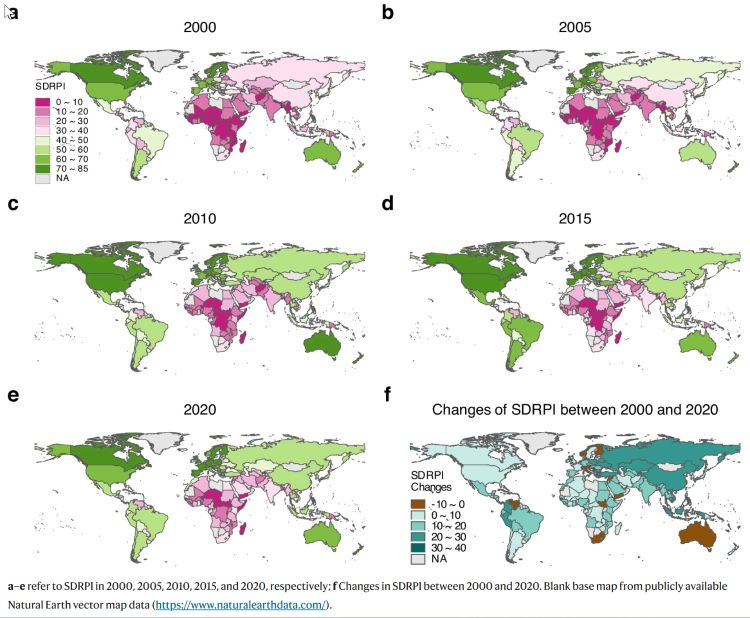New Global Study Reveals Gains and Gaps on Path to Sustainable Development Goals
An international team, including CSIS members and Alumni, developed three indices—SDRPI, SDGI, and SDCI—to measure global SDG performance, imbalances, and coordination over time and across space.

A groundbreaking international study "Assessing global sustainability performance, imbalance, and coordination over space and time" published today in Nature Communications introduces new tools to assess how well countries around the world are advancing toward the United Nations’ Sustainable Development Goals (SDGs)—and how balanced and coordinated their progress has been over the past two decades. While most countries have improved their overall sustainability performance since 2000, significant imbalances persist both between and within nations.
The researchers, including CSIS members at Michigan State University (MSU) and CSIS Alumni from University of Hong Kong and China Agricultural University, developed three innovative indices to provide the most comprehensive global evaluation and analysis of SDG progress from 2000 to 2020:
-
- Sustainable Development Relative Performance Index (SDRPI): measures how countries perform relative to one another in achieving the SDGs.
- Sustainable Development Gini Index (SDGI): captures how balanced a country’s progress is across all 17 goals.
- Sustainable Development Coordination Index (SDCI): evaluates how well countries’ improvements across goals are aligned and mutually reinforcing.
By applying these tools to 115 countries across 2000–2020, researchers analyzed 102 indicators from 115 countries between 2000 and 2020, reveals that global sustainability performance improved overall, with most countries narrowing gaps in development and inequality. Low-income countries made faster progress than high-income nations, showing promising coordination among SDGs. However, major imbalances remain, especially across environmental and economic goals.
“Our findings show that countries are moving in the right direction, but progress is uneven and uncoordinated in many cases,” said Jianguo “Jack” Liu, co-corresponding author, Rachel Carson Chair in Sustainability and director of the Center for Systems Integration and Sustainability at MSU. “Achieving the SDGs by 2030 will require targeted, coordinated action to address lagging areas.”
The findings reveal that most countries improved their sustainable development performance over the past two decades, with narrowing gaps between high- and low-income nations. However, significant imbalances remain, particularly in renewable energy, infrastructure, and data capacity. Among the key findings:
-
- Global improvement: The average SDRPI score rose from 28.5 in 2000 to 39.8 in 2020, with nearly 90% of countries showing progress.
- Narrowing imbalances: Average SDGI values fell from 0.43 to 0.33, indicating more balanced progress among SDGs.
- Rising coordination: Low-income countries, particularly in Africa and Asia, displayed higher coordination in SDG improvements than wealthier nations.
- Top performers: Sweden, Spain, and Germany achieved the highest overall performance, while several Eastern European nations—such as Serbia and Belarus—made the largest gains.
- Lagging targets: Renewable energy (SDG 7.2), infrastructure (SDG 9.1), scientific research (SDG 9.5), and data capacity building (SDG 17.18) showed the weakest progress globally.
The authors emphasize that understanding imbalances and coordination among SDGs can help policymakers design integrated strategies that maximize synergies—such as improving renewable energy access while reducing poverty and inequality—while avoiding trade-offs that undermine sustainability.
“The world has made encouraging progress, but much remains to be done,” said Dr. Zhenci Xu, lead author from The University of Hong Kong. “Our indices offer practical tools for governments, organizations, and researchers to track, compare, and coordinate sustainable development efforts more effectively. The SDRPI helps identify lagging regions and sectors, the SDGI pinpoints internal imbalances between goals, and the SDCI reveals where synergistic policies could have the greatest impact.”
The study also highlights the growing importance of global cooperation and cross-border spillover effects—how countries’ actions influence sustainability outcomes elsewhere through trade, investment, and environmental linkages.
The authors conclude that achieving the SDGs by 2030 will require a shift towards more targeted, context-specific governance that addresses both within-country imbalances and the complex synergies and trade-offs between different goals.
In addition to Liu and Xu, the article was authored by Xiuzhi Chen (China Agricultural University), Qutu Jiang (University of Hong Kong), Xutong Wu (Beijing Normal University), Nishan Bhattarai (University of Oklahoma), John Mullen (Rowan University), Zhongbin B. Li (Wuhan University), Georgina G. Gurney (James Cook University, Australia), Shuxin Li (MSU), Canbing Li (Shanghai Jiaotong University), Tuo Yin (China Agricultural University), Sumin Bian (Westlake University), Jian Zhang (Lanzhou University), Siqi Han (China Agricultural University), Yunkai Li (China Agricultural University).



 Print
Print Email
Email
